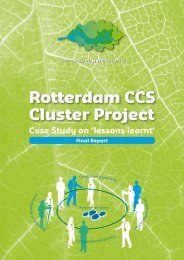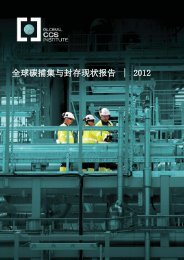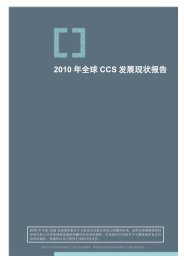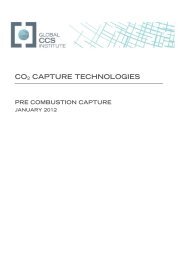Perceptions of CO2 Report - Global CCS Institute
Perceptions of CO2 Report - Global CCS Institute
Perceptions of CO2 Report - Global CCS Institute
- No tags were found...
You also want an ePaper? Increase the reach of your titles
YUMPU automatically turns print PDFs into web optimized ePapers that Google loves.
5.1 Responses collected: Values and knowledge <strong>of</strong> CO 2The first part <strong>of</strong> the survey was identical for all participants. It requested participants’ values andbeliefs about climate change and renewable energy, and it recorded their knowledge <strong>of</strong> CO 2 ’scharacteristics, effects, sources, and uses. These questions were based on the concepts that were<strong>of</strong>ten raised by respondents in the interviews and focus groups. Additionally, respondents ratedhow sure they were <strong>of</strong> their answers on a 1 to 5 scale, where answer option 1 indicated they weresure the given statement was not true; answer option 5 indicated they were sure that the givenstatement was true; and answer option 3 indicated that they were uncertain <strong>of</strong> their response.5.2 Information provided: <strong>CCS</strong> introductionNext, the survey presented respondents with brief introductory information on <strong>CCS</strong>, including anexplanatory diagram <strong>of</strong> the technology. The information was based on an introductory textdeveloped for and used in previous research into <strong>CCS</strong> perceptions <strong>of</strong> the lay public by theEuropean-funded Near<strong>CO2</strong> project (Upham & Roberts, 2011).5.3 First assessment: <strong>CO2</strong> impression, <strong>CCS</strong> impression and <strong>CCS</strong>acceptance measuresImpressions <strong>of</strong> CO 2 and <strong>CCS</strong> were measured before and after respondents received additionalinformation about CO 2 and <strong>CCS</strong>. They were measured using four scales with opposing adjectiveson each end: ‘negative-positive;’ ‘dirty-clean;’ ‘useless-useful;’ ‘dangerous-safe;’ and for <strong>CCS</strong>, anadditional scale: ‘developing technology-mature technology.’ Respondents could indicate whichadjective on the scale best represented their impressions <strong>of</strong> CO 2 and <strong>CCS</strong>. In addition,respondents indicated to what extent they would oppose or accept implementation <strong>of</strong> <strong>CCS</strong> storagein their country, neighbourhood, and <strong>of</strong>fshore under the seabed <strong>of</strong> their nearest sea. In theanalysis, this first set <strong>of</strong> questions on CO 2 and <strong>CCS</strong> is referred to as the first assessment.5.4 Information provided: The nine conditionsAfter the introductory text on <strong>CCS</strong> and the first measures <strong>of</strong> CO 2 and <strong>CCS</strong> perceptions andacceptance, the overall sample <strong>of</strong> respondents was divided into nine separate conditions, each <strong>of</strong>which received information from one or more <strong>of</strong> four different sets:• CO 2 properties (Information part A) listed information on CO 2 ’s chemistry, properties,toxicity, and uses; the greenhouse effect; and places where CO 2 exists.• CO 2 impact and natural phenomena (Information part B) described CO 2 ’s impacts andnatural phenomena involving it, e.g., hot springs with CO 2 in Japan and Germany and theLake Nyos incident.• CO 2 behaviour in <strong>CCS</strong> (Information part C) described how CO 2 would behave at theinjection stage, storage stage, and in the occurrence <strong>of</strong> CO 2 leakage during <strong>CCS</strong>. This textwas largely based on the information provided in the Information Choice Questionnaire (deBest-Waldhober, et al., 2009) and checked by experts for accuracy and balance.• Control (Information part D) repeated the introductory information and diagram <strong>of</strong> <strong>CCS</strong>presented earlier in the survey.Understanding how individuals perceive carbon dioxide | 11
















